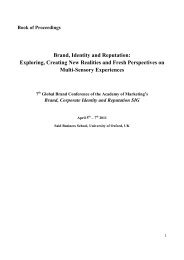DESIGN AND ANALYSIS OF A GRADING SIZE MACHINE
DESIGN AND ANALYSIS OF A GRADING SIZE MACHINE
DESIGN AND ANALYSIS OF A GRADING SIZE MACHINE
Create successful ePaper yourself
Turn your PDF publications into a flip-book with our unique Google optimized e-Paper software.
effected in a bed resting on a ragging screen. The bed is fluidized by a vertical pulsating<br />
motion created by a diaphragm and incoming flow of hutch water, coupled with a bed of<br />
intermediate specific gravity particles of ‘ragging’. The pulsating and dilating action of<br />
this motion on the bed causes the heavier particles (high specific gravity and size) to<br />
sink into and through the ragging to form a concentrate underflow, and lighter and<br />
smaller particles to form a tailing overflow. [5]<br />
1. Conventional Jigs<br />
Figure 2.3.2.2: Graeffe E-Tanks (Conventional Jig)<br />
Source: Keene Hydromatic (1985)<br />
There are many variations of a conventional jig. One of the example is ‘Russell ’.<br />
This consists of two parallel feed boxes each of which discharges into two sets of cells<br />
arranged in series. The feed slurry flows over the two hutches where it is subjected to the<br />
forces described above. The high specific gravity (SG)/coarse grains pass through the<br />
ragging and screens into the hutches where they are removed as an underflow<br />
concentrate, while the remainders of slurry discharges into an overflow launder as<br />
tailings. [5]<br />
9
















